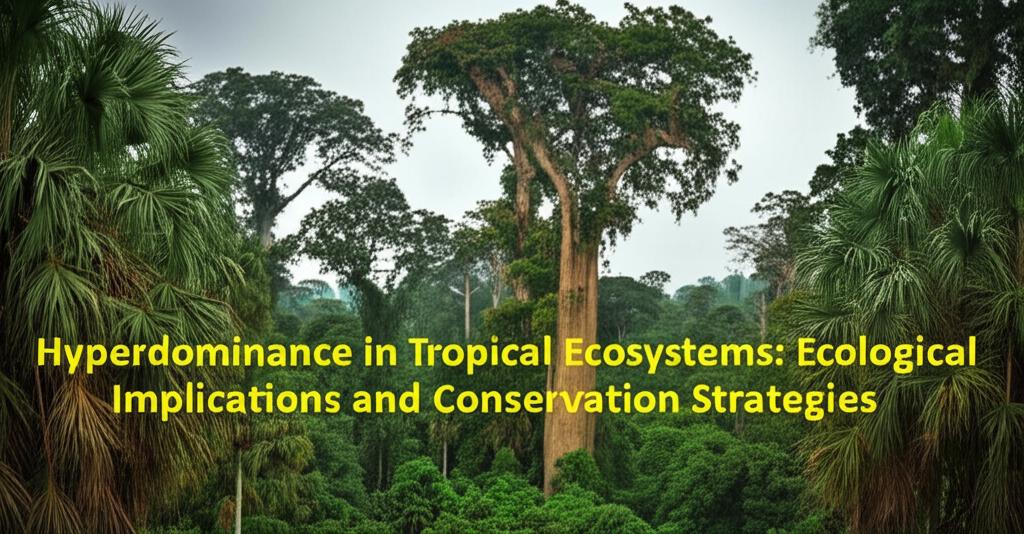Tropical ecosystems, renowned for their staggering biodiversity, often exhibit a phenomenon known as hyperdominance, where a small number of species account for a large proportion of the individuals within the community. This pattern has significant ecological implications and presents unique challenges and opportunities for conservation.
What is Hyperdominance?Hyperdominance describes a situation where a few species are exceptionally common, while many others are rare. For instance, research in the Amazon rainforest has shown that a mere 1.4% of tree species (around 227 species) make up half of all the individual trees in the vast region. Similarly, a recent study in the Cerrado, the world's most tree-diverse savanna, found that just 30 tree species (less than 2%) comprise nearly half of all trees. This pattern is not limited to trees; it has been observed across different size classes and vertical strata of forests, from the understory to the upper canopy, with different species dominating each level.
Ecological Implications of Hyperdominance:The dominance of a few species has profound effects on ecosystem structure and function:
- Ecosystem Processes: Hyperdominant species can disproportionately influence crucial ecosystem processes such as carbon storage, nutrient cycling, and fruit production. Understanding their role is vital as they can be key to maintaining the core functionality of the ecosystem. For example, in the Amazon, about 1% of tree species are responsible for 50% of carbon storage and productivity.
- Resilience and Stability: Some studies suggest that hyperdominant species may possess traits, like wider niche breadths, that make them more resilient to environmental changes, potentially contributing to ecosystem stability. However, this concentration of function also presents a vulnerability.
- Vulnerability to Change: If these key hyperdominant species are negatively affected by disturbances like climate change, deforestation, or disease, the entire ecosystem could be significantly disrupted. The loss of these species could lead to a cascade of effects, potentially altering the fundamental nature of the habitat.
- Habitat Structure: Dominant species, particularly large trees, play a crucial role in structuring the habitat, influencing microclimate, water availability, light intensity, and thus the diversity of understory species.
- Taxonomic Challenges: Accurately identifying species is crucial. Some research indicates that what appears to be a single hyperdominant species may, in fact, be a complex of multiple, genetically distinct lineages or even separate species. This has major implications, as some of these "hidden" species might be rare, geographically restricted, and threatened, requiring different conservation approaches. Resolving these species complexes can refine our understanding of biodiversity, rarity, and ecosystem functioning.
The existence of hyperdominance necessitates tailored conservation strategies:
- Prioritizing Hyperdominant Species: Given their significant role in ecosystem functioning, conservation efforts can focus on protecting hyperdominant species and their habitats. This approach could be an efficient way to safeguard essential ecosystem services.
- Addressing Threats to Key Species: Understanding the specific threats faced by hyperdominant species (e.g., susceptibility to drought, fire, or specific logging practices) is critical for developing targeted conservation actions.
- Considering All Forest Strata: Conservation plans should recognize that different species may be dominant in different layers of the forest (understory, midstory, canopy). A comprehensive approach that considers all strata is needed.
- Taxonomic Research: Investing in taxonomic research, including morphological, genomic, and functional data, is essential to accurately identify species and understand true patterns of dominance and rarity. This can help uncover cryptic diversity and identify previously unknown threatened taxa.
- Habitat Protection and Restoration: Protecting large, intact forest areas is crucial. For degraded areas, restoration efforts should consider the ecological roles of dominant species.
- Managing for Resilience: Given that environmental conditions are changing, strategies that enhance the resilience of hyperdominant species and the broader ecosystem are important. This might include maintaining habitat connectivity to allow for species movement and gene flow.
- Understanding Different Dominance Patterns: Not all dominant species are the same. Some may be locally abundant but regionally rare, while others are widespread. Understanding these different patterns of dominance is crucial for tailoring conservation efforts.
- Monitoring and Adaptive Management: Continuous monitoring of hyperdominant populations and the overall ecosystem health is vital to assess the effectiveness of conservation strategies and adapt them as new information emerges. For instance, understanding how environmental heterogeneity structures forest responses to climate change can improve models of tropical ecosystems.
- Addressing Fragmentation and Land-Use Change: Deforestation, habitat fragmentation, and land-use change are major threats to hyperdominant species and the ecosystems they support. Conservation strategies must address these large-scale drivers of biodiversity loss. Edge effects, for example, can significantly impact vegetation dynamics and the survival of trees in fragmented forests.
In conclusion, hyperdominance is a widespread and ecologically significant feature of tropical ecosystems. While it simplifies some aspects of ecosystem management by highlighting key species, it also underscores the vulnerability of these systems if those dominant species are compromised. Effective conservation requires a nuanced understanding of hyperdominance, accurate species identification, and strategies that protect both the dominant species and the overall ecosystem integrity in the face of ongoing environmental change.

